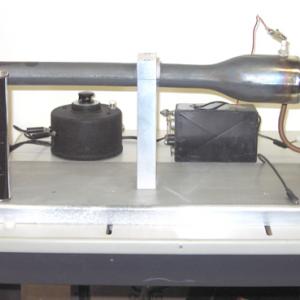College of Liberal Arts & Sciences
1N10.75 - Pulse Jet Engine
See also 10C10.35 in Chemistry and Physics of Everyday Experience.
Place the engine cart behind the bench so that it is well away from the students (it gets very hot when running). Hook the air line for the engine to the compressed air in the lecture room. Fill the fuel tank with lighter fluid (this gives about 25 seconds of run time). Pre-heat the combustion chamber with the propane torches so that portions of it glow red hot. Continue to heat the chamber until the engine starts. Turn on the induction coil and then carefully turn on the compressed air so that the air/fuel mixture is forced into the engine by way of the engines "venturi". When the correct flow rate is reached the engine will pop and then run continuously. At this time the pre-heating with the torches can be discontinued, the spark coil turned off, and the compressed air flow can be turned off.
This engine is very loud so be sure to tell everyone in the audience to cover their ears. It is very impressive to turn out the lights when the engine is running as the combustion and exhaust chambers glow red hot, and you can also see the shock wave striations in the exhaust gasses exiting the engine.
- Brandan-Gillogly, "Hot Rod Anything! Behold, Thrust!", Hotrod Magazine, May 2013, p. 16.
- "Build a Pulse Jet", Popular Mechanics, Apr. 2011, p. 76.
- Seth Porges, "Welcome to the Brooklyn Academy of Mechanical Arts and Ballistic Sciences", Popular Mechanics, May 2010, p. 75.
- J.H. Lemelson and R.F. Probstein, "Model Jet Planes Top 140 m.p.h.", Popular Science, Aug. 1948, p. 164.
- "First Jet Engined Flight", Guinness World Records, 2003, p. 154.
Disclaimer: These demonstrations are provided only for illustrative use by persons affiliated with The University of Iowa and only under the direction of a trained instructor or physicist. The University of Iowa is not responsible for demonstrations performed by those using their own equipment or who choose to use this reference material for their own purpose. The demonstrations included here are within the public domain and can be found in materials contained in libraries, bookstores, and through electronic sources. Performing all or any portion of any of these demonstrations, with or without revisions not depicted here entails inherent risks. These risks include, without limitation, bodily injury (and possibly death), including risks to health that may be temporary or permanent and that may exacerbate a pre-existing medical condition; and property loss or damage. Anyone performing any part of these demonstrations, even with revisions, knowingly and voluntarily assumes all risks associated with them.
